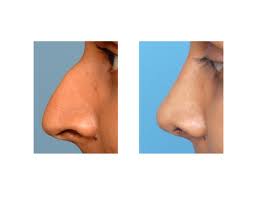Rhinoplasty surgery can change many structural elements of one’s nose. With nearly twenty different cartilage, bone and soft tissue components of the nose, a great diversity of nasal changes is possible. With so many contributing elements, it can be difficult at times to predict how changing one nasal area will affect how others will look. Therein lies the challenge of getting predictable rhinoplasty surgery outcomes that are satisfying to every patient.
One dominant element of the nose is the dorsal profile. This is the line or profile of the nose that runs from where it takes off from the forehead down to the tip of the nose. While it is best seen in a side profile, it also contributes to how the nose looks in an oblique or quarter profile as well as even from viewing the nose straight on. The ideal dorsal profile is fairly straight. Well known and common deformities of the dorsal profile is the nasal hump, albeit small or large. This is a convex dorsal line deformity. A dorsal hump is one of the common nasal problems that makes a patient seek rhinoplasty surgery and such humps have been surgically treated for centuries. The converse of the dorsal hump is the saddle nose or a concave dorsal line. While often caused by injury or a previous rhinoplasty, it equally occurs naturally in certain ethnic noses as well.

Since the radix marks the position of the takeoff of the upper end of the nose, it impacts the appearance of nasal length. A high radix lengthens the nose, creates an overprojected dorsum and draws attention to it and away from the nasal tip. A low radix creates more of a bottom heavy nose, draws attention to the tip and gives it a scooped out appearance.

Reduction of the high radix can not be done by rasping or shaving alone. This only gets the lower end of the radix and will not make a signficant difference. It requires an osteotome to reduce it after an initial osseocartilaginous reduction is done. This may need to be combined with a direct osteotomy done through a punch incision by a small osteotome through the nasal skin from above as well. Guarded rotary drills can also be used to burr the radix down as well.
Augmentation of the radix requires either cartilage grafts or an implant. Cartilage is preferred, usually from the septum, and works well when smaller grafts are needed. Large grafts may require other donor sources such as the ear or even rib. The ease of using synthetic implants is very appealing and under the thick skin high up on the nose may be the safest place to use them. Materials such as Gore-tex and Medpor are the most commonly used. Using silicone implants is more precarious because of their higher incidence of shifting and malposition.
Alteration of the radix of the nose is a subtle aspect of rhinoplasty that is often overlooked. Computer imaging in preoperative planning can help determine if its manipulation is aesthetically beneficial.
Dr. Barry Eppley
Indianapolis, Indiana


